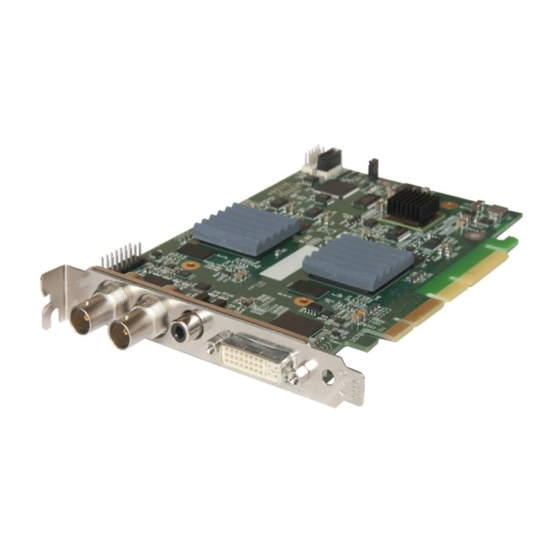Table of Contents
Advertisement
Quick Links
Advertisement
Table of Contents

Summary of Contents for Datapath The VisionAV-SDI
- Page 1 The VisionAV-SDI Audio/Video Capture Card User Manual Version 1.0.0...
-
Page 2: Table Of Contents
Triple Channel Video......................2 Flexible Audio Capture......................2 Datapath Unified Vision Driver....................2 Models..........................2 Optional Accessories......................2 Specification........................3 Unpacking..........................4 Installing the Capture Card....................5 Using the Optional Audio Module (AM2)................7 DirectShow.........................9 Software Installation......................9 Application Overview......................10 Using the card with other Datapath products..............10 Datapath Limited.......................11 Index..........................12... -
Page 3: Introduction
Introduction The VisionAV-SDI has three independent video capture channels – one supporting HD capture, a second decoding Standard Definition composite video and the third, a HD-SDI capture supporting SD-SDI, HD-SDI and 3G-SDI, all channels can be captured simultaneously. The VisionAV-SDI also adds HDMI audio capture which can be perfectly synchronised with either video capture channel. -
Page 4: Triple Channel Video
Flexible Audio Capture • HDMI audio through HD Video Channel Analog Audio • Through optional Audio Module AM2 Datapath Unified Vision Driver • Multiple cards per system • Frame sync and time stamping • Direct Show interface • Datapath RGBEasy API... -
Page 5: Specification
HDMI Capture • Supports HDMI 1.3 to 225MHz (including deep colour modes). For HDCP support, contact the Sales Dept at Datapath for more information • HDMI audio can be selected as source for audio streaming • Incorporates TMDS equalizer to support up to 20m cables DVI Capture Supports DVI 1.0 RGB 24bit capture to 165MHz... -
Page 6: Unpacking
Power Requirements Max current at 12V – 0.5A Max current at 3.3V – 0.8A Thermal dissipation – 6.5W (typical) Operating Temperature 0 to 35 ºC ( 32 to 96ºF) Storage Temperature -20 to 70 ºC ( -4 to 158ºF) Relative Humidity 5% to 90% non-condensing Warranty 3 years... -
Page 7: Installing The Capture Card
• Power up the PC and commence the software installation How to Connect Input Sources The VisionAV-SDI card has one DVI-I, one RCA (female) connector and one BNC (Green LED) connector. The DVI-I connector supports DVI, HDMI, Component and RGB (VGA) inputs using the supplied adapters where required. - Page 8 A Component input is connected to the DVI-I connector using the supplied DVI-Component Adapter: An RGB (VGA) input is connected to the DVI-I connector using the supplied DVI-VGA Adapter: A Standard Definition input is connected directly into the RCA (female) connector on the VisionAV-SDI card:...
-
Page 9: Using The Optional Audio Module (Am2)
Using the Optional Audio Module (AM2) Audio is connected to the AM2 using the Audio Break Out cable provided with the AM2: Balanced (XLR) Input Left Balanced (XLR) Input Right Unbalanced Input Left Unbalanced Input Right Audio Out Left Audio Out Right... - Page 10 In order to control the order in which the driver uses the cards, it is recommended when installing multiple cards that the J6 links on the VisionAV-SDI are configured. The example below shows the jumper link settings for up to 32 cards in a single system. When two cards share the same link settings, their order is...
-
Page 11: Directshow
The program will run, however no notifications are displayed. Firmware Upgrades The VisionAV-SDI cards allow firmware upgrade to be completed on site rather than returning the card to Datapath. Whenever a firmware upgrade is performed, the J8 Link MUST BE FITTED on the VisionAV-SDI. -
Page 12: Application Overview
• CD / DVD ROM Drive Using the card with other Datapath products The VisionAV-SDI captures data and stores it in an on-board video buffer. This data is then copied using DMA to the host system for display, storage or streaming. -
Page 13: Datapath Limited
Datapath Limited Datapath has a long and very successful history in the computer graphics industry. Datapath has been designing and supplying high performance, high quality graphics display systems to the world’s larg- est and most demanding companies and institutions since 1982. Datapath was one of the founding companies of multi-screen Windows acceleration using single and multi board solutions. -
Page 14: Index
Index application 10 Input Sources 5 Audio 7 Installing the Capture Card 5 Audio Break Out cable 7 Audio feed 5 J8 link 9 Balanced XLR 2 Multiple cards 8 Multiple Cards 8 Component input 6 Copyright Statement 11 packing box 4 Datapath 11 RGBEasy API 2 Datapath CD 9 RGB (VGA) input 6 Datapath Limited 11 Direct3D 10 software 9 DirectShow 9 Standard Definition 6 DirectShow interface 9 Standard Definition input 6 dplinks program 9 DVI input 5 Technical Support 11 Firmware Upgrades 9 Unpacking HDMI 5 video buffer 10 HDMI input 6 Help File 9...















Need help?
Do you have a question about the The VisionAV-SDI and is the answer not in the manual?
Questions and answers